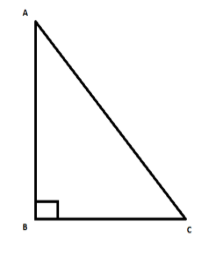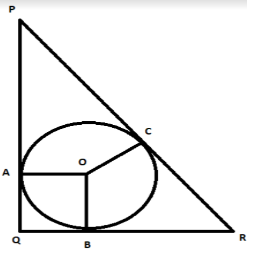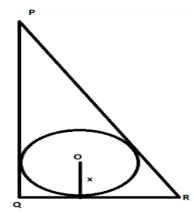
Answer
480.3k+ views
Hint: If two tangents are drawn from a point to a circle, then the length of those two tangents from that particular point to the circle will be equal. In this question, $PQ,QR$ and $PR$ are the tangents to the circle.
In this question, we are given a right angle triangle having sides $PQ=24$cm, $QR=7$cm and $\angle
PQR={{90}^{\circ }}$. We can calculate the length of side $PR$ by using Pythagoras theorem.
Consider a triangle $ABC$ having $\angle ABC={{90}^{\circ }}$.

Using Pythagoras theorem the relation between the base, perpendicular and the hypotenuse of the
triangle is given by,
$AC=\sqrt{{{\left( AB \right)}^{2}}+{{\left( BC \right)}^{2}}}.....................\left( 1 \right)$
Using Pythagoras theorem from equation $\left( 1 \right)$ in the triangle $PQR$, we get,
$PR=\sqrt{{{\left( PQ \right)}^{2}}+{{\left( QR \right)}^{2}}}$
In the question, it is given $PQ=24$cm, $QR=7$cm.
$\begin{align}
& \Rightarrow PR=\sqrt{{{\left( 24 \right)}^{2}}+{{\left( 7 \right)}^{2}}} \\
& \Rightarrow PR=\sqrt{576+49} \\
& \Rightarrow PR=\sqrt{625} \\
& \Rightarrow PR=25 \\
\end{align}$
Since the circle is inscribed in the triangle $PQR$, sides $PQ,QR,PR$ will act as a tangent to the
circle. Let us name the point of contact of circle with the tangent $PQ$ as $A$, tangent $QR$ as $B$
and tangent $PR$ as $C$. Let us join the point $A,B,C$ to the center of the circle $O$ . Also, let us
consider the radius of the circle equal to $x$.

Since $OA,OB,OC$ are the radius, their lengths are equal to $x$.
It can be seen from the figure that in quadrilateral $AOQB$, two adjacent sides ($OA,OB$) are equal
(since they are the radius of the circle) and all the angles are right angles. This means, $AOQB$ is a
square. So, $AQ=x$ and $BQ=x$.
There is a property of tangent which states that, if two tangents are drawn from a point to a circle,
then the length of those two tangents from that particular point to the circle will be equal. Using this
property in the above triangle,
$\Rightarrow PA=PC,QA=QB,RB=RC............\left( 2 \right)$
We have obtained $AQ=x$. Also $PQ=24$. Since $PAQ$ is a straight line, we can say,
$\begin{align}
& PA=PQ-QA \\
& \Rightarrow PA=24-x \\
\end{align}$
From $\left( 2 \right)$, we have $PA=PC$.
$\Rightarrow PC=24-x............\left( 3 \right)$
Also, we have obtained $BQ=x$. Also $QR=7$. Since $QBR$ is a straight line, we can say,
$\begin{align}
& RB=QR-QB \\
& \Rightarrow RB=7-x \\
\end{align}$
From $\left( 2 \right)$, we have $RB=RC$.
\[\Rightarrow RC=7-x............\left( 4 \right)\]
Since $PCR$ is a straight line, we can write,
$PR=PC+RC$
Using Pythagoras theorem, we obtained $PR=25$cm. Also, from equation $\left( 1 \right)$ and
equation $\left( 2 \right)$, we have $PC=24-x$ and \[RC=7-x\]. Substituting in the above equation,
we get,
$\begin{align}
& 25=24-x+7-x \\
& \Rightarrow 2x=6 \\
& \Rightarrow x=3 \\
\end{align}$
Hence, the radius of the inscribed circle is $3$.
Note: There is an alternative method to find the radius of the inscribed circle. The radius of the
inscribed circle of a triangle is given by the formula, $r=\dfrac{K}{s}$ where $K$ is the area of the
triangle and $s$ is the half of the perimeter of the triangle.
In this question, we are given a right angle triangle having sides $PQ=24$cm, $QR=7$cm and $\angle
PQR={{90}^{\circ }}$. We can calculate the length of side $PR$ by using Pythagoras theorem.
Consider a triangle $ABC$ having $\angle ABC={{90}^{\circ }}$.

Using Pythagoras theorem the relation between the base, perpendicular and the hypotenuse of the
triangle is given by,
$AC=\sqrt{{{\left( AB \right)}^{2}}+{{\left( BC \right)}^{2}}}.....................\left( 1 \right)$
Using Pythagoras theorem from equation $\left( 1 \right)$ in the triangle $PQR$, we get,
$PR=\sqrt{{{\left( PQ \right)}^{2}}+{{\left( QR \right)}^{2}}}$
In the question, it is given $PQ=24$cm, $QR=7$cm.
$\begin{align}
& \Rightarrow PR=\sqrt{{{\left( 24 \right)}^{2}}+{{\left( 7 \right)}^{2}}} \\
& \Rightarrow PR=\sqrt{576+49} \\
& \Rightarrow PR=\sqrt{625} \\
& \Rightarrow PR=25 \\
\end{align}$
Since the circle is inscribed in the triangle $PQR$, sides $PQ,QR,PR$ will act as a tangent to the
circle. Let us name the point of contact of circle with the tangent $PQ$ as $A$, tangent $QR$ as $B$
and tangent $PR$ as $C$. Let us join the point $A,B,C$ to the center of the circle $O$ . Also, let us
consider the radius of the circle equal to $x$.

Since $OA,OB,OC$ are the radius, their lengths are equal to $x$.
It can be seen from the figure that in quadrilateral $AOQB$, two adjacent sides ($OA,OB$) are equal
(since they are the radius of the circle) and all the angles are right angles. This means, $AOQB$ is a
square. So, $AQ=x$ and $BQ=x$.
There is a property of tangent which states that, if two tangents are drawn from a point to a circle,
then the length of those two tangents from that particular point to the circle will be equal. Using this
property in the above triangle,
$\Rightarrow PA=PC,QA=QB,RB=RC............\left( 2 \right)$
We have obtained $AQ=x$. Also $PQ=24$. Since $PAQ$ is a straight line, we can say,
$\begin{align}
& PA=PQ-QA \\
& \Rightarrow PA=24-x \\
\end{align}$
From $\left( 2 \right)$, we have $PA=PC$.
$\Rightarrow PC=24-x............\left( 3 \right)$
Also, we have obtained $BQ=x$. Also $QR=7$. Since $QBR$ is a straight line, we can say,
$\begin{align}
& RB=QR-QB \\
& \Rightarrow RB=7-x \\
\end{align}$
From $\left( 2 \right)$, we have $RB=RC$.
\[\Rightarrow RC=7-x............\left( 4 \right)\]
Since $PCR$ is a straight line, we can write,
$PR=PC+RC$
Using Pythagoras theorem, we obtained $PR=25$cm. Also, from equation $\left( 1 \right)$ and
equation $\left( 2 \right)$, we have $PC=24-x$ and \[RC=7-x\]. Substituting in the above equation,
we get,
$\begin{align}
& 25=24-x+7-x \\
& \Rightarrow 2x=6 \\
& \Rightarrow x=3 \\
\end{align}$
Hence, the radius of the inscribed circle is $3$.
Note: There is an alternative method to find the radius of the inscribed circle. The radius of the
inscribed circle of a triangle is given by the formula, $r=\dfrac{K}{s}$ where $K$ is the area of the
triangle and $s$ is the half of the perimeter of the triangle.
Recently Updated Pages
How many sigma and pi bonds are present in HCequiv class 11 chemistry CBSE

Mark and label the given geoinformation on the outline class 11 social science CBSE

When people say No pun intended what does that mea class 8 english CBSE

Name the states which share their boundary with Indias class 9 social science CBSE

Give an account of the Northern Plains of India class 9 social science CBSE

Change the following sentences into negative and interrogative class 10 english CBSE

Trending doubts
Fill the blanks with the suitable prepositions 1 The class 9 english CBSE

The Equation xxx + 2 is Satisfied when x is Equal to Class 10 Maths

In Indian rupees 1 trillion is equal to how many c class 8 maths CBSE

Which are the Top 10 Largest Countries of the World?

How do you graph the function fx 4x class 9 maths CBSE

Give 10 examples for herbs , shrubs , climbers , creepers

Difference Between Plant Cell and Animal Cell

Difference between Prokaryotic cell and Eukaryotic class 11 biology CBSE

Why is there a time difference of about 5 hours between class 10 social science CBSE




